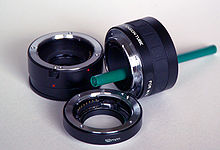
An extension tube, sometimes also called a closeup tube or an extension ring, is used with interchangeable lenses to increase magnification. This is most often used in macro photography. [1]

An extension tube, sometimes also called a closeup tube or an extension ring, is used with interchangeable lenses to increase magnification. This is most often used in macro photography. [1]


The tube contains no optical elements; its sole purpose is to move the lens farther from the image plane. The farther away the lens is, the closer the focus, the greater the magnification, and also the greater the loss of light (requiring a longer exposure time). [2] Lenses classically focus closer than infinity by moving all optical elements farther from the film or sensor; an extension tube simply enables this movement.
Because extension tubes do not have optics, they do not affect the optical quality of a lens. Because of their function, there are other effects: decrease of light; shallower depth of field; and loss of ability to focus at infinity. The longer the extension tube, the closer the lens can focus. Correspondingly, the amount of light and depth of field will be reduced. [3] On modern cameras using auto exposure the decrease in exposure is all corrected for by the camera, but when not using auto exposure this has to be calculated and taken into account when setting exposure. The exposure compensation, called the bellows factor, is a dimensionless ratio that is applied to the relative aperture (f-number), resulting in the working f-number of the lens and extension tube combination.
The precise reduction of the amount of light reaching the imaging plane can be calculated using the inverse square law formula.
Extension tubes without electrical contacts will not allow an electronic automatic camera to control the lens, thus disabling autofocus and in some cases forcing a user to shoot wide open unless the lens offers manual aperture control. More expensive extension tubes contain electrical contacts allowing the user to use autofocus and electronically control the aperture of the attached lens. An advantage to the non-electrical tubes is their lower price.
Other items like lens adapters may unintentionally have an effect similar to an extension tube. A lens designed for a small flange focal distance may not be able to focus to infinity when a lens adapter places the sensor too far away.
Extension tubes are sometimes confused with teleconverters, an optical component (i.e., containing lenses) designed to increase effective focal length.
A close-up lens also enables focusing closer for macro photography but, unlike an extension tube, a close-up lens actually is an optical element.
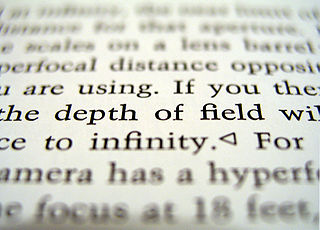
The depth of field (DOF) is the distance between the nearest and the furthest objects that are in acceptably sharp focus in an image captured with a camera.

A single-lens reflex camera (SLR) is a camera that typically uses a mirror and prism system that permits the photographer to view through the lens and see exactly what will be captured. With twin lens reflex and rangefinder cameras, the viewed image could be significantly different from the final image. When the shutter button is pressed on most SLRs, the mirror flips out of the light path, allowing light to pass through to the light receptor and the image to be captured.

A camera is an instrument used to capture and store images and videos, either digitally via an electronic image sensor, or chemically via a light-sensitive material such as photographic film. As a pivotal technology in the fields of photography and videography, cameras have played a significant role in the progression of visual arts, media, entertainment, surveillance, and scientific research. The invention of the camera dates back to the 19th century and has since evolved with advancements in technology, leading to a vast array of types and models in the 21st century.

A view camera is a large-format camera in which the lens forms an inverted image on a ground-glass screen directly at the film plane. The image is viewed, composed, and focused, then the glass screen is replaced with the film to expose exactly the same image seen on the screen.
The focal length of an optical system is a measure of how strongly the system converges or diverges light; it is the inverse of the system's optical power. A positive focal length indicates that a system converges light, while a negative focal length indicates that the system diverges light. A system with a shorter focal length bends the rays more sharply, bringing them to a focus in a shorter distance or diverging them more quickly. For the special case of a thin lens in air, a positive focal length is the distance over which initially collimated (parallel) rays are brought to a focus, or alternatively a negative focal length indicates how far in front of the lens a point source must be located to form a collimated beam. For more general optical systems, the focal length has no intuitive meaning; it is simply the inverse of the system's optical power.

A camera lens is an optical lens or assembly of lenses used in conjunction with a camera body and mechanism to make images of objects either on photographic film or on other media capable of storing an image chemically or electronically.

In optical engineering, an objective is an optical element that gathers light from an object being observed and focuses the light rays from it to produce a real image of the object. Objectives can be a single lens or mirror, or combinations of several optical elements. They are used in microscopes, binoculars, telescopes, cameras, slide projectors, CD players and many other optical instruments. Objectives are also called object lenses, object glasses, or objective glasses.

The EF lens mount is the standard lens mount on the Canon EOS family of SLR film and digital cameras. EF stands for "Electro-Focus": automatic focusing on EF lenses is handled by a dedicated electric motor built into the lens. Mechanically, it is a bayonet-style mount, and all communication between camera and lens takes place through electrical contacts; there are no mechanical levers or plungers. The mount was first introduced in 1987.

Macro photography is extreme close-up photography, usually of very small subjects and living organisms like insects, in which the size of the subject in the photograph is greater than life size . By the original definition, a macro photograph is one in which the size of the subject on the negative or image sensor is life size or greater. In some senses, however, it refers to a finished photograph of a subject that is greater than life size.
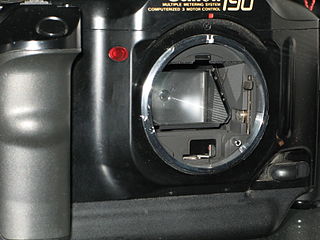
The Canon FD lens mount is a physical standard for connecting a photographic lens to a 35mm single-lens reflex camera body. The standard was developed by Canon of Japan and was introduced in March 1971 with the Canon F-1 camera. It served as the Canon SLR interchangeable lens mounting system until the 1987 introduction of the Canon EOS series cameras, which use the newer EF lens mount. The FD mount lingered through the release of the 1990 Canon T60, the last camera introduced in the FD system, and the end of the Canon New F-1 product cycle in 1992.
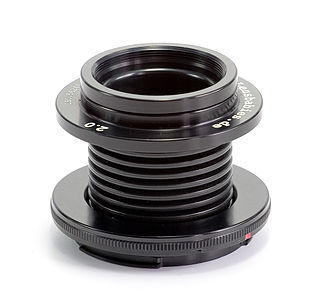
Lensbaby is a line of camera lenses for DSLR and mirrorless cameras that combine a simple lens with a bellows or ball and socket mechanism for use in special effect photography. A Lensbaby can give effects normally associated with view cameras. The lenses are for use in selective focus photography and bokeh effects.

The EF 50mm lenses are a group of normal prime lenses made by Canon that share the same focal length. These lenses are based on the classic double-Gauss lens, with the f/1.8 being a standard six-element double-Gauss with an air gap and powers between element 2 and 3 and its faster cousins adding additional elements. The 50mm focal length, when used with a 35mm film or full-frame sensor, has been widely considered to match the perspective seen by the human eye.

A telecentric lens is a special optical lens that has its entrance or exit pupil, or both, at infinity. The size of images produced by a telecentric lens is insensitive to either the distance between an object being imaged and the lens, or the distance between the image plane and the lens, or both, and such an optical property is called telecentricity. Telecentric lenses are used for precision optical two-dimensional measurements, reproduction, and other applications that are sensitive to the image magnification or the angle of incidence of light.

Tilt–shift photography is the use of camera movements that change the orientation or position of the lens with respect to the film or image sensor on cameras.
The Canon EF 100 mm lenses are used for Canon DSLR cameras. There are four different types of EF 100 mm lens for Canon. Certain lenses are best for macro photos, whereas other lenses are good for taking pictures of subjects from a distance.

In photography, a close-up lens is a simple secondary lens used to enable macro photography without requiring a specialised primary lens. They work like reading glasses, allowing a primary lens to focus more closely. Bringing the focus closer allows the photographer more possibilities.

This article details lensesfor single-lens reflex and digital single-lens reflex cameras. The emphasis is on modern lenses for 35 mm film SLRs and for "full-frame" DSLRs with sensor sizes less than or equal to 35 mm.

The Micro Four Thirds system is a standard released by Olympus and Panasonic in 2008, for the design and development of mirrorless interchangeable lens digital cameras, camcorders and lenses. Camera bodies are available from Blackmagic, DJI, JVC, Kodak, Olympus, Panasonic, Sharp, and Xiaomi. MFT lenses are produced by Cosina Voigtländer, DJI, Kowa, Kodak, Mitakon, Olympus, Panasonic, Samyang, Sharp, Sigma, SLR Magic, Tamron, Tokina, TTArtisan, Veydra, Xiaomi, Laowa, Yongnuo, Zonlai, Lensbaby, Venus Optics and 7artisans amongst others.
The Fujica X-mount was a lens mount created by Fujifilm in the late 1970s and early 1980s for the new Fujica SLR lineup: AX-1, AX-3, AX-5, AX Multi, STX-1, STX-1N, STX-2, MPF105X, MPF105XN. It replaced the M42 screw mount used on their earlier SLRs.
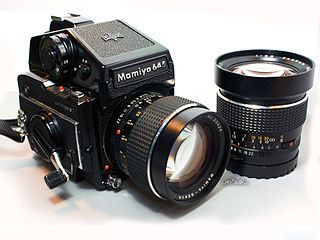
The Mamiya 645 camera systems are a series of medium format film and digital cameras and lenses manufactured by Mamiya and its successors. They are called "645" because they use the nominal 6 cm x 4.5 cm film size from 120 roll film. They came in three major generations: first-generation manual-focus film cameras, second-generation manual-focus film cameras, and autofocus film/digital cameras.